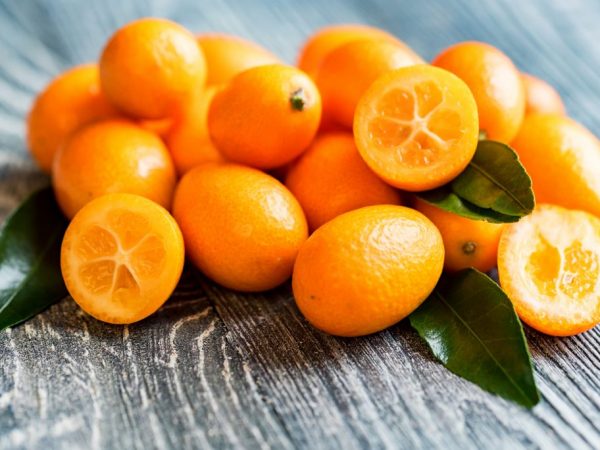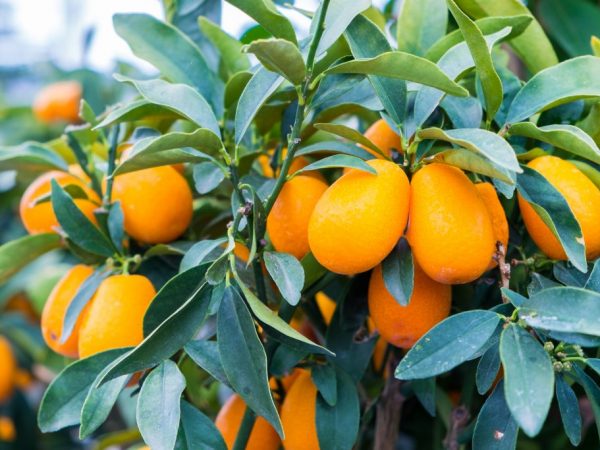Citrus kumquat
Citrus kumquat belongs to the rue family. He is originally from Indochina. It is widespread in the wild, but its cultivation is acceptable at home.

Citrus kumquat
Botanical characteristic
The kumquat plant in natural conditions grows up to 3-4 m, when grown at home it reaches a height of 1.5 m.It has a strongly branched dense spherical crown formed by small dark green foliage 4-6 cm in length and 1.5-2 cm in width, having translucent glands and a smooth surface.
The scientific name "fortunella" is a citrus fruit named after the gardener-collector Robert Fortune who brought it from China to Europe. Translated, its Japanese name means "golden orange".
The flowers are axillary, white, located singly or 2-3 in inflorescences. Fruits are round, small in size, 2.0-2.5 cm in diameter, weighing up to 30 g. The color of the peel is golden-orange. The fruit resembles small elongated oranges in appearance.
Citrus bears fruit in late winter and early spring, 2-3 months after the flowering stage. The fruit tastes like tangerine and is slightly sour. Not only the pulp is edible, but also the peel.
Area
The main place of growth is the southern part of China. But the kumquat is also cultivated:
- in the southeastern part of Asia,
- in Japan,
- in the Middle East,
- in the European south, especially in Greece, on the island of Corfu,
- in the southern part of America, especially in the state of Florida.
The culture prefers fertile sandy loam soils, requires moderate humidity, grows in well-lit places where the temperature regime is kept within 25-30 ° С. Some varieties are able to withstand temperatures as low as -10-15 ° C.
Chemical composition
The chemical composition of 100 g of kumquat contains:
- vitamins: 43.9 mg ascorbic acid, 0.037 mg B1, 0.090 mg B, 0.429 mg B3, 0.208 mg B5, 0.036 mg B6, 290 mg A, 0.15 μg E,
- trace elements: 62 mg calcium, 186 mg potassium, 0.86 mg iron, 0.095 mg copper, 20 mg magnesium, 10 mg sodium, 19 mg phosphorus, 0.17 mg zinc,
- fatty acids: 0.103 g saturated, 0.154 g unsaturated, 0.171 g polyunsaturated.
Calorie content - 71 kcal per 100 g of product, where:
- up to 80.85% - water,
- up to 1.88% - proteins,
- up to 0.86% - fats,
- up to 6.5% - dietary fiber,
- up to 15.9% - carbohydrates.
Varieties

The Nagami variety is best suited for growing at home.
There are 6 types of kinkan.
Nagami
Nagami is the most popular variety, also known as Margarita. It is a large shrub that bears fruit all year round and is frost-resistant. The fruit resembles a large olive in appearance.
Has subspecies:
- Nordmann. Differs in the absence of seeds,
- Variegated. It is a small plant without thorns with cream or pale yellow foliage, oblong fruits, at the stage of formation they have longitudinal stripes that disappear when ripe.
Fukushi
Fukushi is a variety with a lush symmetrical crown. It has stems without thorns and wide oval leaves.
The species is resistant to low temperatures, has pear-shaped fruits that are larger than other species, up to 5 cm long.
Marumi
Citrus Marumi grows up to 2.7 m high. It is distinguished by an increased number of thorns on the stems. Fruits are slightly flattened, rounded, up to 3.2 cm long.
Outwardly, the variety resembles Nagami, winter-hardy.
Hongkong
The Hong Kong species differs from others in dry fruits the size of small peas. Their diameter is up to 2.0 cm, because the plant also has the name "golden bean". Fruits of this type are almost never eaten.
It is a dwarf plant, its height is up to 1.0 m. The thorns on the stems of the crop are shorter than those characteristic of other crops.
The main place of growth is Hong Kong and several Chinese regions closest to it.
In Chinese cooking, the fruit is often used as a condiment.
Meiva
Meiva is a rare variety with fruits up to 4 cm in diameter, distinguished by bright taste and an external resemblance to lemon. It also tastes like this fruit.
Malay
The variety grows in the Malay Peninsula, where it is grown as a hedge.
Growing at home
At home, kumquat often grows as a houseplant. It is rarely grown from seeds: young citrus kumquat seedlings have a weak root system, therefore it is problematic to care for seedlings.
The most suitable citrus variety for indoor cultivation is Nagami, which is often used in decorative bonsai gardens.
In the process of care, the plant is provided with abundant regular watering and frequent spraying, especially in the summer season. It needs a transplant every 2-3 years. It does not bear fruit without the introduction of fertilizing complexes during the care process. At the growth stage, potassium and phosphorus fertilizers are applied once every 10 days, at the resting stage - once every 30 days.
Conclusion
Kumquat can be eaten fresh and processed. It is a component in the preparation of jams, marmalade and liqueurs. Some varieties are grown as an ornamental houseplant.


